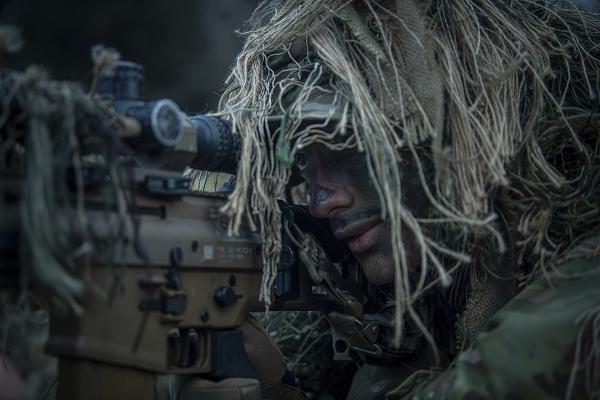
Santa Maria Regional Airport, California. (February 28, 2024): In the movies snipers always belong to the Army or Marine Corps, sharp shooters from the Air Force get very little attention. In this photo by Staff Sergeant Scott Warner, 14th Air Support Operations Squadron tactical air control craftsman Staff Sergeant Aaron Weaver aims his SCAR MK 20 sniper rifle at the enemy while playing the opposing force during exercise Agile Flag 24-1.
Sergeant Weaver is a member of the Air Force’s “Close Precision Engagement Teams” charged with protecting flight lines and other vital areas of bases around the world. They also conduct perimeter defense, counter sniper operations, reconnaissance, and surveillance. Each team is composed of two individuals, the sniper and the spotter. The spotter uses a long-range scope to identify targets, gather range and windage adjustments, and relays this information to the sniper. The sniper makes the adjustments on the M-24 and fires on the target.
Snipers must be able to operate independently and make quick decisions in high pressure situations. They also play a vital role collecting intelligence on enemy activity which gives commanders situational awareness. These missions require patience, attention to detail, and the ability to remain calm in often chaotic situations. As one can imagine, becoming an Air Force sniper requires extensive training and a high level of mental and physical discipline.
To become an Air Force sniper, candidates attend an eleven-day Advanced Designated Marksman Course that familiarizes students with the M24 weapon system. Next, students attend a nineteen-day Close Precision Engagement Course at Fort Bliss, Texas. The course teaches advanced marksmanship, military scouting skills, and field tactics. The course is very physically demanding with PT drills every day, obstacle courses, and forced marches. Instructors watch to see how their students perform when exhausted and under severe stress.
The course includes target detection, range estimation, camouflage, concealment, and how to use the famous ghillie suit. Students learn to blend into their environment using the terrain and vegetation of the area. To graduate, students must pass a series of combat “stalks” where they creep up on a target without being detected by the instructor.
Most recently, Air Force Close Precision Engagement Teams served in both Iraq and Afghanistan.


